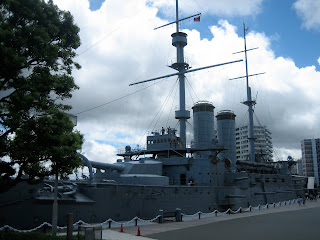
Yesterday I went to Mikasa Park - and much as that may sound like the Japanese equivalent of a song penned by Jimmy Webb, it's in fact a stately space by the seaside in Yokosuka, located right next the U.S. naval base there.
A previous resident of Yokosuka was William Adams, the inspiration for the British hero John Blackthorne in James Clavell's tome Shōgun, back in the 17th century; he was more recently channeled by Richard Chamberlain in the 1980 TV miniseries.
It was also in the southern part of Yokosuka in the mid 1850s that Commodore Matthew Perry arrived with his fleet of Black Ships, to force the opening of diplomatic and trade relations between Japan and the United States.
Almost one hundred years later American occupation forces landed at Yokosuka (on 30 August 1945, after the surrender of Japan) and the naval base has been used by the US Navy since then.

Yokosuka crops up as the locality of the Sega video game Shenmue, as well as being blown up in the futuristic tactical RPG Front Mission 3.
Director Imamura Shohei set his 1961 film Pigs and Battleships (豚と軍艦) in Yokosuka, and the place was the location of climactic fisticuffs in the Godzilla film Terror of Mechagodzilla (メカゴジラの逆襲, 1975).
But the real reason I went down there was for an exceptionally big ship.
The Mikasa is a pre-dreadnought battleship ordered from Britain by Japan in 1898 and took three years to complete, at the cost of £880,000 (¥8.8 million). Upon arrival in these waters the ship ended up becoming the flagship of Admiral Heihachiro Togo, Commander-in-Chief of the Japanese Grand Fleet during the Russo-Japanese War (1904-1905).

Named after Mount Mikasa in Nara, the Mikasa is in fact the last pre-dreadnought ship in the world, a survivor of the Russian conflict, running aground in fog in 1921, decommissioning later that year, retirement as a memorial ship in 1926, bombing in World War 2, and extensive dismantling during Japan's demilitarization thereafter.
Restoration work, in conjunction with the U.S. Navy, brought the old lady back to life and she was opened to the public in 1961. Now it's a nifty museum with its own cinema, models, paintings and documents, many of the compartments look as they did in Togo's time, and there're some hilarious mannequins "manning" cannons.
The main guns (seen above with a ring-in, unsuspecting live bystander to get a gist of their size) had a range of 10 kilometres and fired projectiles weighing 400 kilograms. It took 40 people to operate them, surrounded by armour weighing in at around 50 tons.

The ship was the major setting for Nihonkai Daikaisen: Umi Yukaba (1983) - variously known in English as Battle of the Japan Sea and Battle Anthem, it tells the story of a young musician assigned to Mikasa’s shipboard band, and depicts the Battle of Tsushima Straits in 1905.
At Tsushima the Mikasa led the combined Japanese fleet into one of the most decisive naval battles in history - almost annihilating their Russian foes.
The movie starred the great Toshiro Mifune as Admiral Togo; it was directed by Toshio Masuda, who helped make Tora! Tora! Tora! in 1970 as well working on the anime Space Battleship Yamato series - and was involved as the producer on its 2009 reboot Rebirth Yamato.

There's also an NHK drama called Sakanoue no Kumo, screened last year, which portrays a rapidly modernizing Meiji Japan (1867-1915) and has extensive location and press shots around the Mikasa.
But the best find of this little expedition was the Admiraali Export Beer with Admiral Togo's face on it (see first picture above), which I'm partaking of now as I write these words.
It's quite the tasty amber drop. Yum!